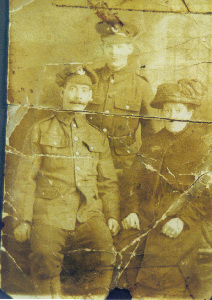
Shields Gazette Friday 10/11/1916
Medal Index Card
Private W R Nessworthy

W R Nessworthy James Hoy Archive

William and brother undentified. Their mother Jane
Robert was christened 10th July at 1889 St Hilda's Church, South Shields.
William Robert Nessworthy was the eldest of seven children, Thomas, born 10th April 1889, Elizabeth, July 1890, Matthew, born 3rd October 1891, James, born 1893, Jane Elizabeth born 1897, and Ambrose born 1899.
William was employed as a Grocery assistant and in 1891, he was residing at 16 Wellington Street, South Shields, in 1901 he had moved to 42 Wellington Street.
He was a cartman and was working at Messrs Brigham and Cowan docks at South Shields.
By 1911, Robert was residing at 45 Wellington Street, South Shields.
He enlisted into the 14th (Service) Battalion Durham Light Infantry in September 1914, and was allocated service number 14246.
14th (Service) Battalion. Formed at Newcastle in September 1914 as part of K3 and came under orders of 64th Brigade in the 21st Division. Moved to Aylesbury, then Halton Park in October, going on to billets in High Wycombe in November 1914, and then back to Halton Park in April 1915. Finally moved to Witley in July. On the 11th September 1915, they landed at Boulogne. The 28th November 1915, the 14th Battalion transferred to 18th Brigade in 6th Division.
He was sent to France 11th September 1915.
Private William Robert Nessworthy, from South Shields, was awarded the Military Medal for "conspicuous gallantry and devotion to duty" during the First World War. He helped save at least 10 comrades near Le Sars, France, with fellow medal recipient Lance-Corporal T. Brown, a Lewis gunner, also of the DLI.
All of Lance Corporal Brown's gun teams were either killed or wounded during an attack on the sunken road October 8th 1916. Under enemy fire, he and Pte Nessworthy went forward and swept the road, thereby covering the advance of their company.
The capture of the straggling village called Le Sars, along the Albert-Bapaume Road was the next objective of the 12th Battalion Durham Light Infantry. The attack was to be made by two Brigades 69th Brigade on the left and the 68th Brigade on the right. The 12th Battalion DLI were to attack the 'Tangle' and the Sunken Road, a set of trenches south-east of the village of Le Sars. At 13.00 hrs on the 7th October, 12th DLI, 'C' Company occupied the 'Tangle'. At 13.45 hrs the rest of the Battalion moved up to support them. They were held up by heavy German machine-gun fire. Parts of 'C' and 'D' Company managed to reach the sunken road and were able to inflict heavy casualties on the Germans.
"On the 8th of October at 13.45 hrs a patrol of one officer and eighteen men went forward, the officer and about 5 men managed to reach some shell holes close to the sunken road. They eventually got into the Sunken Road and 'C' Company attacked from the east."
Extract from With Bayonets Fixed by John Sheen, page 185.
The 6th Division with the 14th as a part moved to the Ypres Salient and occupied the Potijze defences on December 11th. Five days later the battalion moved into the front line and on Sunday 19th were attacked with gas and high explosives near the village of Wieltje. 'A' Company had to wear gas helmets for 3 hours and 'D' Company, on lower ground, for 4 hours. Casualties amounted to 149 in the ranks with many attributed to defective gas masks".
On the 19th December 1915,at 5am, the 14th Battalion Durham Light Infantry endured the first phosgene gas attack near Wieltje. Casualties amongst the ranks amounted to 149 with 22 killed and a number of officers also being gassed and wounded.
The DLI's official war diary noted "Casualties in the ranks amounted to 149, but would have been lighter if there had not been so many defective gas helmets."
When he recovered from being gassed, he was transferred to the 12th Battalion Durham Light Infantry.
William was residing at 30 Wellington Street, South Shields by 1916.
He was discharged in 1918 as a Class 'Z' reserve.
William Robert Nessworthy, who was gassed during the war, died of lung cancer in 1951, aged 63. His wife, Johanna, died in 1970.
Footnote: His brothers Ambrose and Matthew both were killed in WW1.
Source: James Hoy Archiveand Photographs from the Nessworthy Family with Thanks.
William Robert Nessworthy is remembered at South Shields on S86.025
Detailed History of the Nessworthy Family
With Bayonets Fixed by John Sheen

